Forum d'Avignon
This year, as in years past, Bain & Company has conducted a global survey measuring how people consume culture in the form of digital media—video, music, e-books and video games. By surveying more than 6,000 consumers in Europe, the US and the BRIC (Brazil, Russia, India and China) countries, we learned about changing preferences for how they watch, listen, read and play.
The survey results highlighted three key trends in 2013:
- The rise of individual and social consumption driven by smartphones and tablets
- The end of content scarcity as digital distribution achieves ubiquity
- A shift away from ownership enabled by "always-on" networks
These changes occur against a backdrop of the persistent culture clash between the creative and digital worlds. Last year we noted the innovative power of digital platforms over the past seven years: iTunes is synonymous with music downloads, YouTube with streaming video, Kindle with e-books. But the rise of giants creates unease. Apple, Google, Amazon, Microsoft and Facebook make headlines as much for the business, regulatory and cultural controversies they generate as for the new behaviors they have fostered.

Why we watch what we watch
As power shifts to consumers, curation moves out of the hands of professionals and into communities, platforms and algorithms.
The rise of digital platforms also highlights the evolving role of curation, as consumers look for better ways to find the culture they want the most. As power shifts to consumers—who can program their own content using powerful technology and simple interfaces—curation moves out of the hands of professionals and into communities, platforms and algorithms. This creates a real danger of a “tyranny of demand,” as indicated by the prevalence of franchises over original creation in increasingly risk-averse industries. Nevertheless, media players that can offer the right content—that is, not only what consumers want today, but what will surprise them tomorrow—are likely to prevail.
We expect the current state of unease and uncertainty to lead to a new balance between supply and demand. Every player in the content ecosystem has a role to play in defining this new equilibrium, around three main issues: transforming the role of content publishers, building consumer insight while addressing privacy concerns and re-charting funding paths for great content.
In light of ever-changing consumer dynamics and business models, we believe content publishers can follow three critical paths:
- Invest in original content and gain a stronger foothold in production
- Build scale to maintain a differentiated access to talent and funding
- Embrace data analytics to complement editorial approaches
Content consumers in 2013: The age of abundance
Our survey of more than 6,000 consumers in eight countries points to three key trends in 2013: the rise of individual consumption driven by smartphones and tablets, the end of content scarcity as digital distribution achieves ubiquity and the shift away from ownership enabled by “always-on” networks.
Devices: From households to individuals
Our 2011 study ("Connected devices and services: Reinventing content") highlighted the growth of connected platforms and their impact on media consumption. Two years later, smartphones and tablets have clearly emerged as the fastest-growing devices. They have reached mass markets not only in Western countries, with more than 60% owning a smartphone and almost 40% owning a tablet, but also in emerging countries, with China and India respectively the first- and third-largest smartphone markets today (see Figure 1.1).
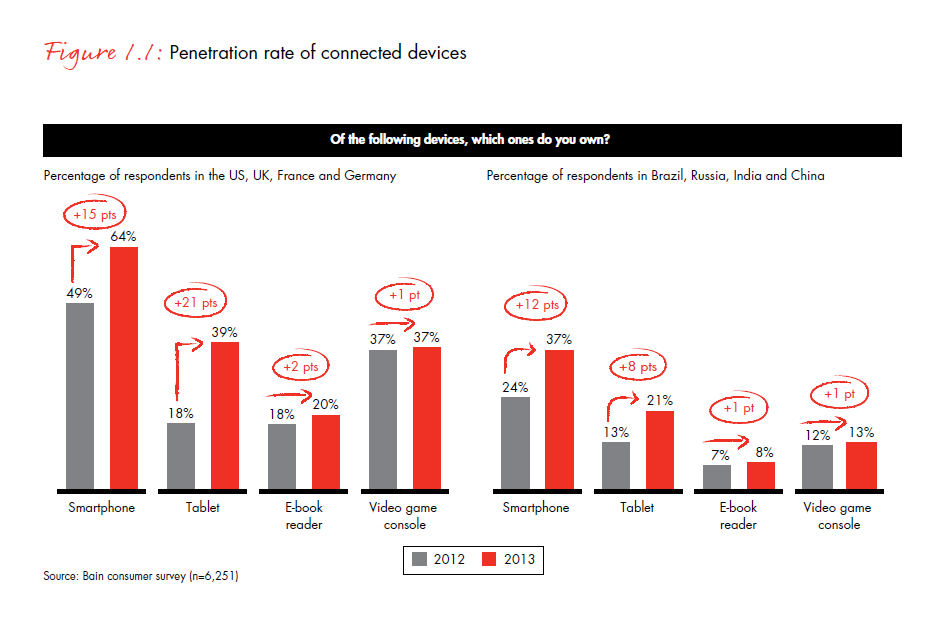
Tablets and smartphones are driving a quiet revolution in the lives of millions of users who listen to, watch, read and play content on them. In Western countries, up to 20% of tablet users aged 15 to 34 use it as their primary device to play games. Among respondents 15 to 34, 25% say they watch less traditional TV in order to watch their programs on mobile screens—twice as high as the percentage of the general population. Tablets and smartphones create new moments of viewing, playing and listening on the go, and more media multitasking than ever. With applications and app stores as the gateway to content, these devices defy both the 60-year-old remote control and the 20-year-old search engine. They challenge the historical notion of household consumption by making content personal, customized to individual tastes and influenced by larger, online social communities rather than by only nearby friends and family.
Content: The end of scarcity
Our survey points to an all-digital future across media markets, arriving at a different pace across video, music, gaming and books. While more than 75% of respondents in the US watch videos online, almost 53% of respondents in Western countries are digital music consumers, and 17% of French respondents have read an e-book over the past year. Ultimately, connected devices and services are likely to erase the scarcity of content and physical shelf space that have long been sources of value in content industries.
Connected devices and services create new opportunities to watch, play and listen, increasing the total time spent consuming media (see Figure 1.2). In Western countries, for instance, almost 70% of subscribers to an online video-streaming service watch more video content than they did three years ago. Nearly 60% of subscribers to a streaming music service spend more time listening to music than they did three years ago. Connected devices tend to create new “times” for consumption (for example, while waiting or commuting), especially for shorter formats (see Figure 1.3). In a world where an unlimited supply of content is always at hand, the only limits are available leisure time.
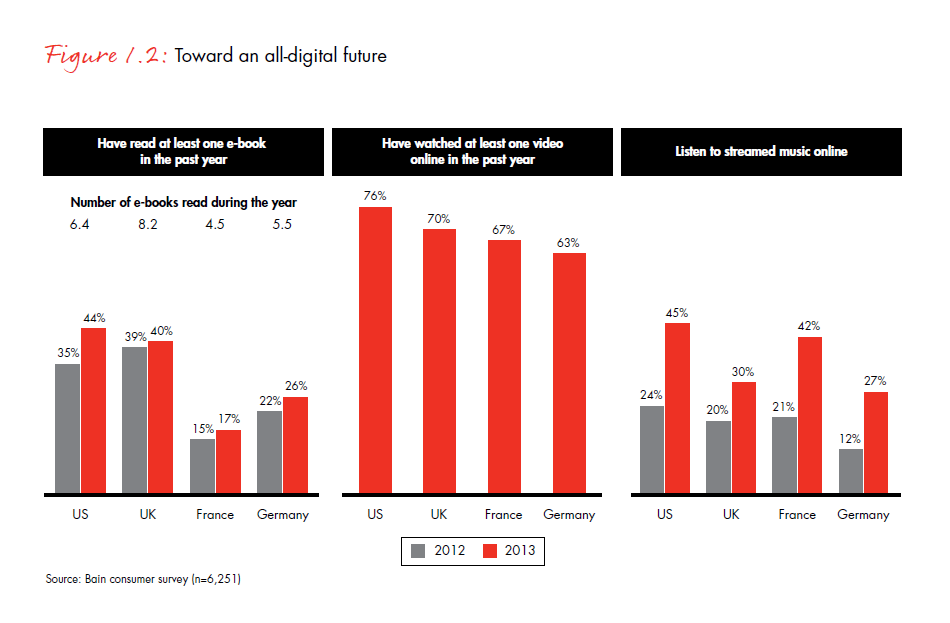
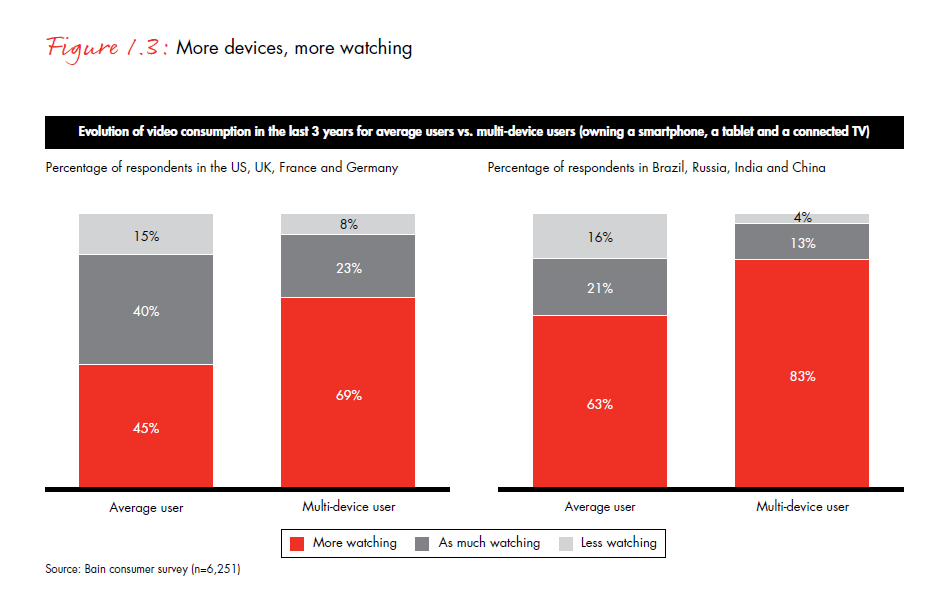
Services: The shift away from ownership
Connected devices and cloud services are changing the distribution models from downloads to streaming (see Figure 1.4). As a direct replacement for CDs and DVDs, downloads were still anchored in the idea that owning content was the best way to ensure convenient access, anytime and anywhere. Subscription services like Netflix in video, Spotify in music or Oyster in books challenge this very notion. These rely on pervasive communication networks to deliver always-on, on-demand models—shifting the value proposition from owning to renting.
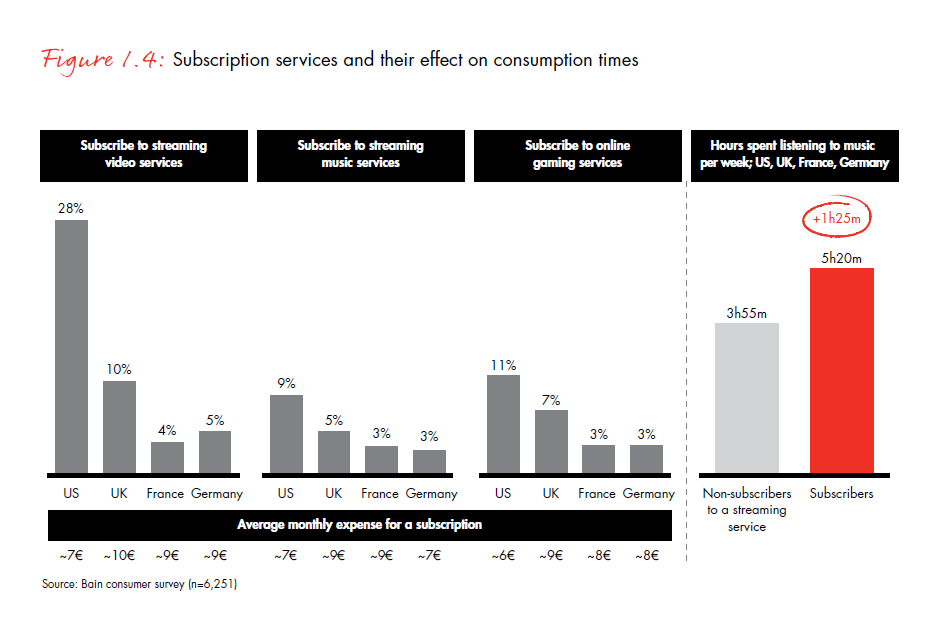
Distribution platforms: The battle for curation
As digital consumption upturns the physical media regime, the decline of traditional content distribution leaves the door open for digital platforms to take the lead. Yet multiple factors could help content industries establish a new balance of power.
The rise of global content distribution platforms
Led by Apple, Google and Amazon, digital platforms have expanded their distribution reach across all types of media. Apple was a pioneer, expanding its original iTunes Music Store to include TV shows, films, books and video games. Around 20% of Apple users we surveyed said they use iTunes for all their content needs ( see Figure 2.1). Google developed its Google Play platform in 2012 through the merger of its Android Market, Google Music and Google eBookstore. Amazon developed its books, DVD and CD stores into a digital download supermarket. And while pushing their respective devices, digital platforms also build on each other’s successes by developing native or Web apps accessible through all platforms, such as Amazon’s Cloud Player. Today, around 20% of respondents in Western countries use Apple or Google for more than two types of media among music, video, games and books; 30% use Amazon for two or more media types.
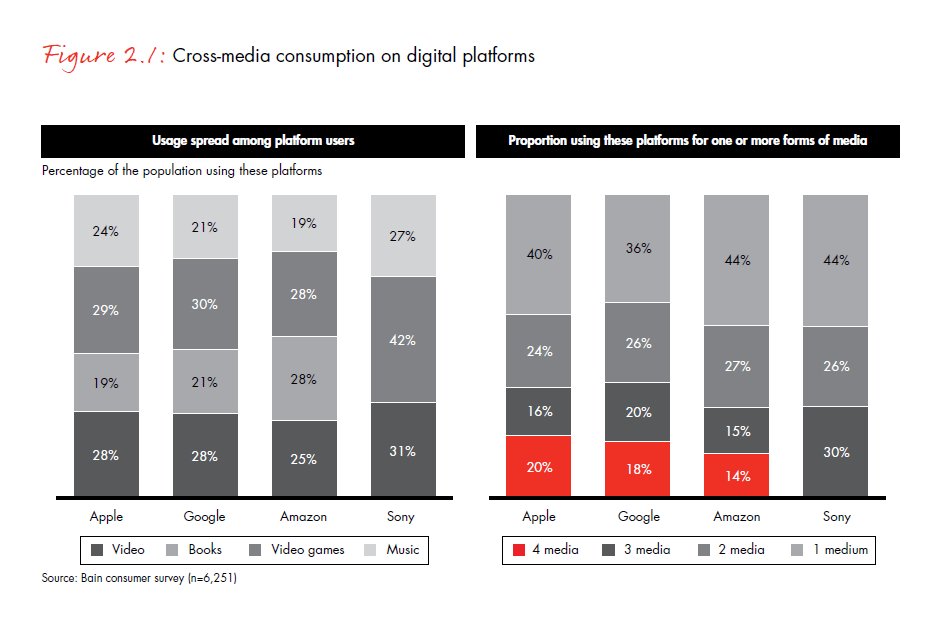
Digital platforms also have a natively global footprint—86% of Western consumers and 68% of BRIC consumers surveyed use at least one of the major platforms. Digital platforms have become the natural destination for content across major media markets in the world.
Digital platforms are also becoming the cornerstone of the content economy with their ability to influence consumer choices. As they embrace new distribution approaches such as Apple’s iTunes Radio service, they move up the content value chain. Social networks, though not publishers or distributors per se, reinforce this phenomenon as user recommendations become critical to content popularity. Facebook is second only to YouTube in terms of worldwide video views today.
Through recommendation engines and social functionalities, these platforms are no longer just distributors, they are also aggregating content and pushing it to individually targeted consumers. Digital platforms are shifting into publisher territory—raising the specter of disintermediation for traditional media companies (see Figure 2.2). Some digital players have even become bona fide content publishers, from Sony acquiring Columbia to create Sony Entertainment back in 1988, to Netflix, YouTube and Amazon investing hundreds of million dollars in new, original content productions—and winning commercial and critical acclaim for their efforts. Netflix, for example, received 14 Emmy nominations in 2013 for its original series House of Cards, Arrested Development and Hemlock Grove.
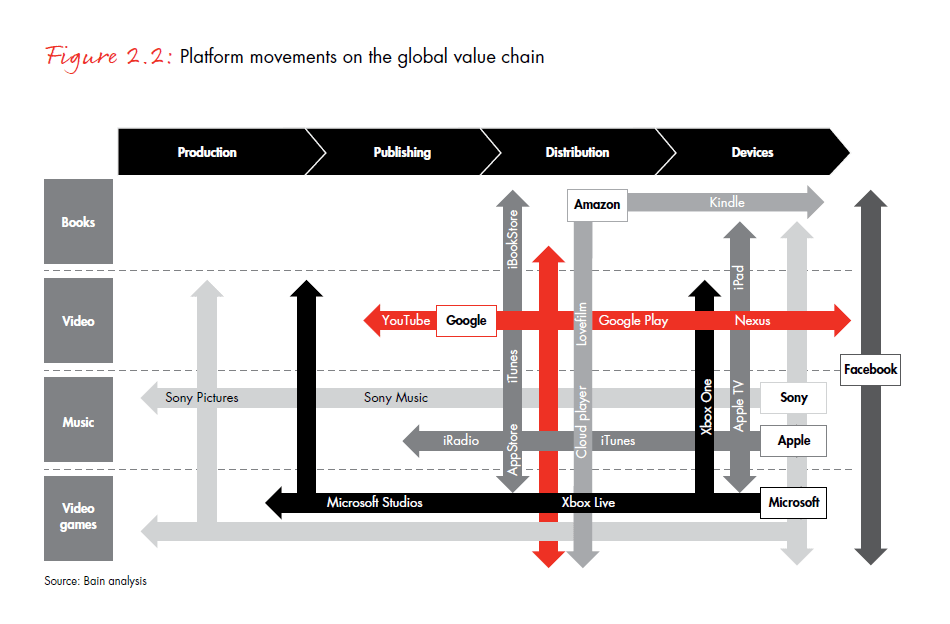
Platform competition heating up
Competition is intensifying among digital platforms. Each pioneered its own domain—Apple in music, Google in video, Amazon in books—but now they aim to serve customers in an integrated ecosystem. While they still rely on each other’s platforms to help them grow—as shown, for example, by Google’s ongoing development of IOS apps for Google Maps and YouTube—their expansion puts them in direct confrontation with each other and additional players. Microsoft has launched a substantial initiative in video by heralding its Xbox One as a new way to watch TV, rather than as "just" a video game console. Tomorrow, Samsung could increase its stakes in the content space in order to support its TV, smartphone and tablet sales.
Today, no platform dominates the entire distribution of cultural goods, but each can build on its position to extend across content markets. Such competition is likely to foster innovation and consumer value. Equally importantly, it should dispel the threat of a single dominant player being able to impose its will upon content producers and publishers—as illustrated by recent debates around Apple and Amazon’s e-book pricing and license fee negotiations between Apple and record companies for its new streaming radio service.
The rise of specialists and the fragmentation of aggregation
Competition is also intensifying with the emergence of platforms that specialize in a particular media type (see Figure 2.3). In music, Spotify, Pandora and Deezer now compete against veteran music services like iTunes and Amazon. Around 35% of digital music consumers we surveyed have used music streaming services. In video, Netflix has gained 90% of the subscription streaming market in the US, putting it ahead of cross-media platforms like iTunes. In video games, Valve’s pioneer platform Steam has maintained strong leadership in the PC market, its model now emulated by Microsoft and Sony on consoles.
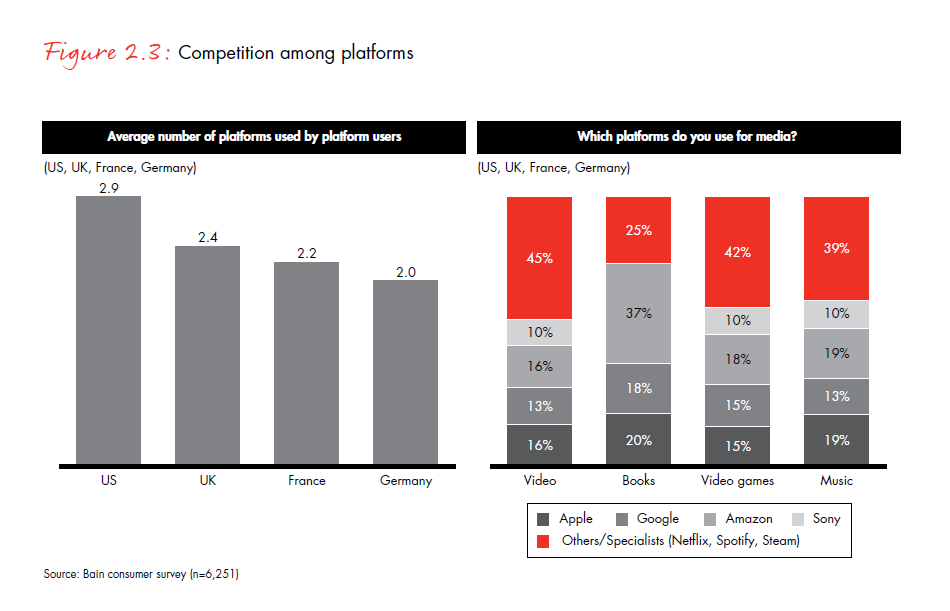
Niche platforms are also on the rise, including Liveleak for information, Howcast for DIY, TwitchTV for live video gaming and College Humor for video content. Blip Networks is another service, which differentiates itself from YouTube by offering restricted access to video content for a limited and handpicked community. Arguing that algorithms do not work for everything, CEO Kelly Day is trying to attract niche publishers that did not benefit from YouTube’s content financing in November 2012. Such specialized players are potential partners for content creators and publishers looking for innovation at the bleeding edge of consumer behaviors.
More generally, digital distribution is evolving towards a more fragmented landscape, combining large and small platforms, prepackaged and self-programmed fare. Such fragmentation recreates a sustainable space for publishers that can deliver content to all consumers, irrespective of which device they own.
Digital curation and the creative economy
Digital platforms encourage a shift to more consumer-led curation. Yet multiple factors point to the sustained role of creativity and supply-driven approaches in the content space.
New curation models
The rapid development of social networks is changing the ways that content is curated and recommended (see Figure 3.1). Every user is now a curator to friends and the larger community beyond, through services like Twitter and Tumblr. Distribution platforms are deepening their integration with social networks to respond to this demand for sharing. Facebook’s integration with Spotify gives any user the ability to share his or her musical tastes with friends. Sony has also announced that social network integration would be core to its new PlayStation 4 gaming experience.
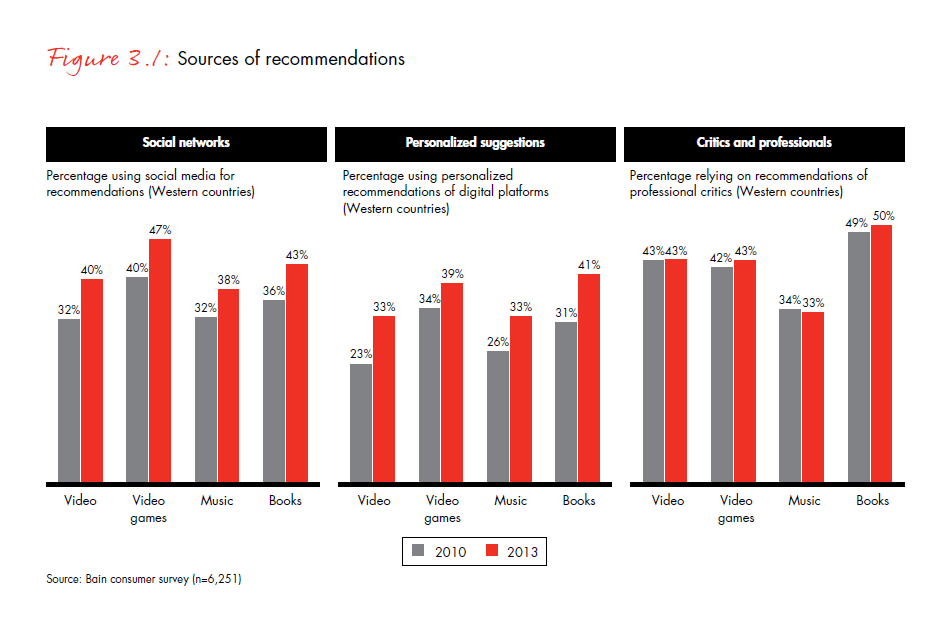
Our survey confirms that sharing playlists with friends, "liking" a film on Facebook or reviewing a book on Amazon have all become mainstream ways to influence consumer choices—now at par with or even above traditional sources of recommendations. Half of videogamers in Western countries choose games based on their friends’ social network recommendations, up from 40% three years ago.
By aggregating and analyzing user behavior—the often-discussed "Big Data"—curation is also becoming automated. More and more consumers trust algorithmic recommendation engines to determine their cultural choices (see Figure 3.2). A Deezer or Netflix user will find songs or films recommended by the service without having to search for additional information on whether the content will appeal to them. For books, 30% of respondents in Western countries trusted such recommendations in 2010, compared with nearly 40% today.
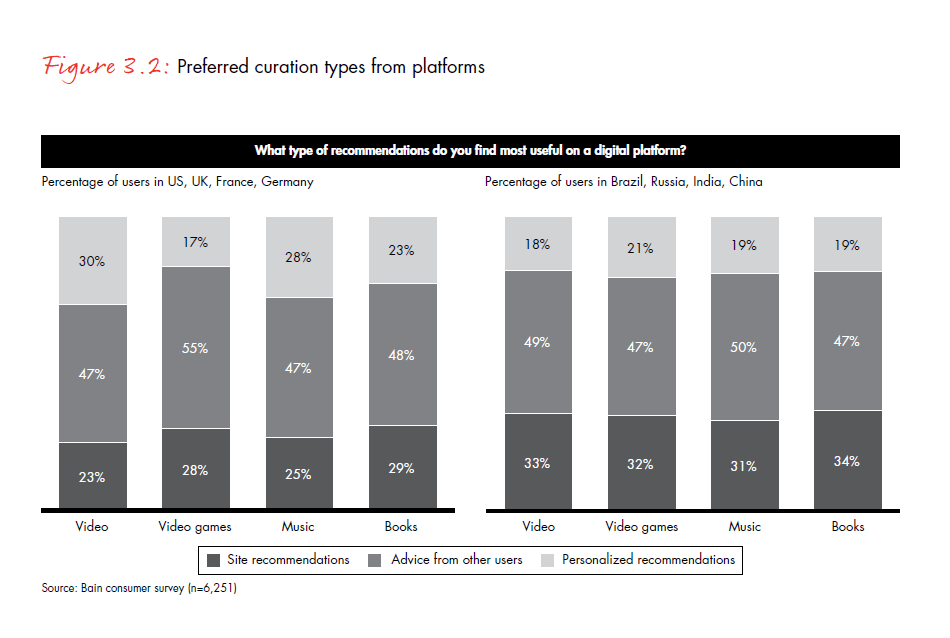
Some approaches combine professional opinion and algorithmic engines to produce editorial authority. For example, Metacritic aggregates the reviews of many professional critics to generate a consensus review—a “metascore”—on video games, films, TV series, DVDs and music. For instance, The Last of Us recently appeared in the top of the video games ranking with a metascore of 95 out of 100, based on critics from sources ranging from The Guardian to Eurogamer. The emergence of such algorithms has deep implications —not only on content consumption but also on creation, as some industry players have adopted them as one tool to assess the potential market for new products, adapting marketing budgets and even incentivizing production studios according to such scores.
Creativity in a demand-driven content economy
Data aggregation and analysis provides digital platforms with precious information on the tastes and needs of consumers. In theory, they are able to define "recipes" to reduce the inherent risk of content production. Based on subscriber profiles and behavior, Netflix commissioned director David Fincher and actor Kevin Spacey to produce its commercial and critical hit House of Cards (released in February 2013 and based on a 1990 British TV show).
But this analytic approach, by suggesting a shift from a supply- to a demand-driven economy, can seem countercultural to the content industry, which has always captured audience imagination through creativity and innovation.
The dangers of such a "tyranny of demand" are real, illustrated by the increasing number of proven franchises among highest-grossing movies as production and marketing budgets swell. In 1981, only three out of the top 10 box office successes were sequels, franchises or adaptations (see Figure 3.3). In 2011, all of the top 10 were. However, alongside this increasingly specific blockbuster economy, original content is alive and kicking, although it has largely moved to television. In 1998, HBO programmed less than 15 hours of marquee original content with two main shows (Oz and Sex and the City); in 2012, it was approximately 100 hours across 10-plus shows. In Europe, the Canal + Groupe followed a similar approach, with ambitious content like Braquo and Borgia, whose quality is recognized both locally and abroad.
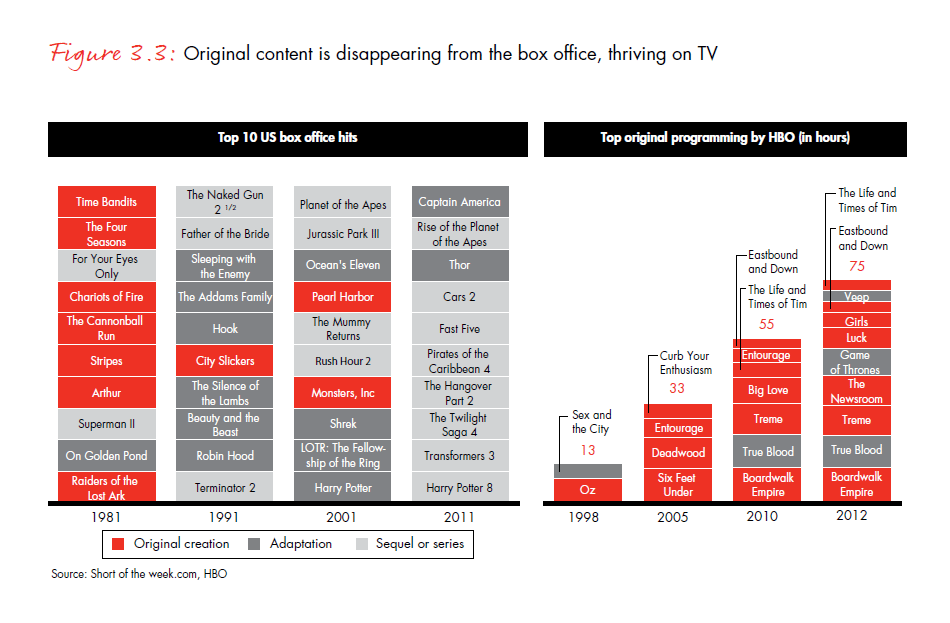
Digital platforms have yet to find their place in this balancing act between proven brands and original content. While iTunes' 2012 movie downloads were dominated by blockbusters and sequels such as The Hunger Games, The Avengers and Men in Black 3, original series are huge successes for Netflix. Ted Sarandos, Netflix's chief content officer, announced that House of Cards was their most viewed content in February 2013. In May 2013, the new season of Arrested Development topped Cards’ record, and the new series Orange Is the New Black recently beat this record again.
Consumers championing creativity
What if digital consumers themselves became promoters of original content? The development of content crowdfunding demonstrates that users today have both the desire and the means to support new creative efforts. In France, fan-funded music label MyMajorCompany has helped finance more than 60 artists since its creation in 2007, including notable success story Grégoire, whose album Toi+Moi has sold more than 1.5 million copies. Video game studios are funding ambitious projects through crowdfunding platform Kickstarter, including Double Fine’s BrokenAge (with a $3 million budget) and Cloud Imperium’s Star Citizen ($18 million). Both were led by industry-recognized talents (Tim Schafer and Chris Roberts, respectively), and had a strong creative vision that found an audience outside of the industry’s prevalent franchise criteria. With budgets far smaller than the tens of millions (hundreds of millions, even, once marketing is included) spent on AAA titles such as Call of Duty and Grand Theft Auto, these ventures are promising examples of alternative creative spaces. Kickstarter has also helped finance several successes in the film space—last year it reported that it financed around 10% of films presented at the Sundance Festival, among which 19 films were selected and four won a prize.
Not all crowdfunded projects will succeed, of course. But the rise of digital platforms and their recommendation algorithms (which don’t differentiate between studio blockbusters and garage efforts) creates new opportunities for creative talents. Amazon, Google Play and iTunes have sometimes been criticized for the cluttered, mechanical nature of their curation models, but they have created space for the emergence of new talents, as products from independents and newcomers appear side by side with those from established producers and publishers.
From abundance to discovery
In order to establish a virtuous balance in the digital content ecosystem, which is driven not only by unorganized abundance but also curated discovery, three issues remain to be addressed: transforming the role of content publishers, building consumer insight while addressing privacy concerns and re-charting funding paths for innovative content.
A new role for content publishers
Faced with more choice than ever and more alternatives to the offers from publishers and distributors, consumers are increasingly empowered to program their own content and build their own packages. Some would like to see in this development the demise of content publishers and TV networks, which are "stuck" between distributors and producers.
However, this ignores the fact that publishers play many critical roles in the content ecosystem beyond programming, around four main activities: R&D, content production, audience development and monetization (see Figure 4.1).
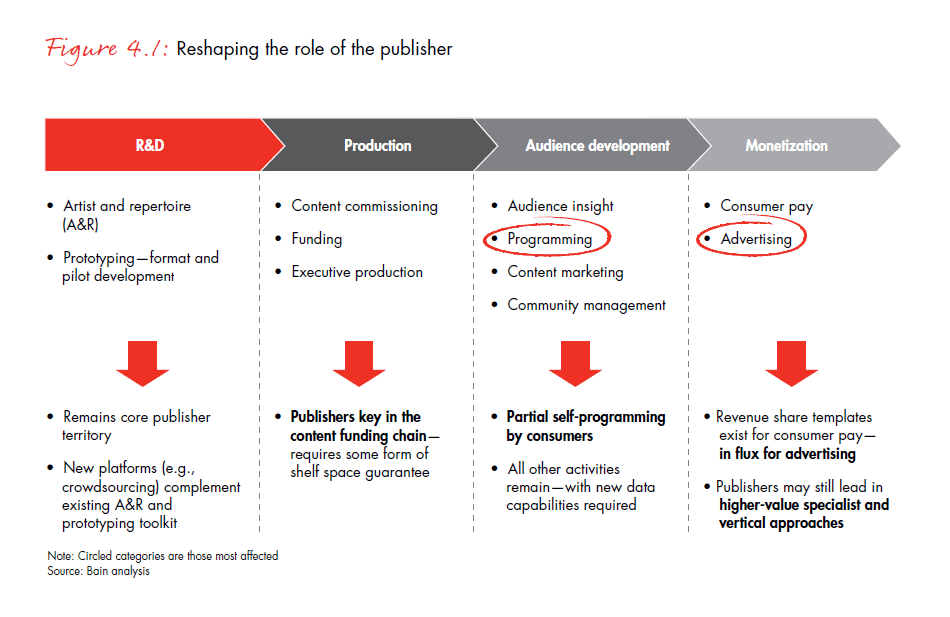
As consumers "vote with their feet" and provide immediate and measurable feedback, low-quality content will struggle more than ever to find a market. Coming up with quality concepts and formats will be all the more important. In our view, the R&D required to build them should remain largely in the hands of publishers. Indeed, essential capabilities such as A&R and format/pilot development require a close connection to diverse, fragmented and largely local producer networks—out of reach for global technology platforms. New talent platforms such as crowdfunding are likely to play a role in this process in the future, but as a complement rather than as a substitute for the existing publisher toolkit, along with traditional approaches, such as A&R and talent shows.
Media companies are also likely to remain essential to fund content production for two main reasons: Independent producers do not have the balance sheet strength required to fund ambitious projects on their own, while digital platforms, increasingly competing against each other, cannot ensure distribution to 100% of the addressable market for a given piece of content. As a result, media companies can be expected to manage relationships with global distribution platforms in order to maximize the exposure of ad-supported content and optimize the monetization of paid content windows.
In the United States, significant vertical integration between content publishers and producers around the big studios (specifically, Disney, Fox, NBCUniversal and Warner Bros.) further ensures some form of stability. This is less true in Europe, where independent production is stronger—in part driven by regulatory constraints on vertical integration. The rise of global platforms and the resulting need for scale in the media industry is therefore likely to fuel the long-lasting debate on the relevance, advantages and drawbacks of such constraints.
We also see opportunities for traditional media to capitalize on their expertise and deep relationships with audiences in order to reassert a valuable position between producers and digital platforms. Certainly, platforms are poised to become an increasingly important point of aggregation in the advertising market with unique reach, customer data and measurability. But high-quality content, targeted at specific market segments or within certain genres, represents a growing opportunity for publishers. By combining their traditional expertise with new techniques including data analysis and viral marketing, they can retain their valuable position as curators in the digital space and play a key role in ensuring quality content finds its audience. Experiments in this direction, such as Comcast leading a $30 million investment round in multichannel network Fullscreen, should help publishers and distributors climb the learning curve in this new domain.
Overall, revenue sharing between platforms and content owners may become increasingly common. Such a scenario would not be unlike the current situation. Today, HBO content coexists on publisher-owned platforms, partner networks and third-party channels. The BBC runs its content on its own broadcast channels as well as on its highly successful platform iPlayer and on BBC-branded YouTube channels.
Traditional content publishers must therefore position themselves aggressively on new curation platforms, bringing their audience and content expertise with them. Beyond mere survival in their local markets, they could find in global distribution platforms the opportunity to export their know-how into new territories historically outside their reach.
The data challenge: Building consumer insight while addressing privacy concerns
New curation approaches all rely extensively on analysis of consumer data. Recent events have highlighted increasing sensitivities on the capture and analysis of personal data. Still, there are significant differences between geographies (see Figure 4.2). Most users in France and Germany are ready to do away with the personalized recommendations they find useful to keep their personal data confidential. On the other hand, consumers in India and China seem much less aware of or less concerned about privacy issues: more than 60% of them would rather obtain personalized recommendations even if it means relinquishing some personal data.
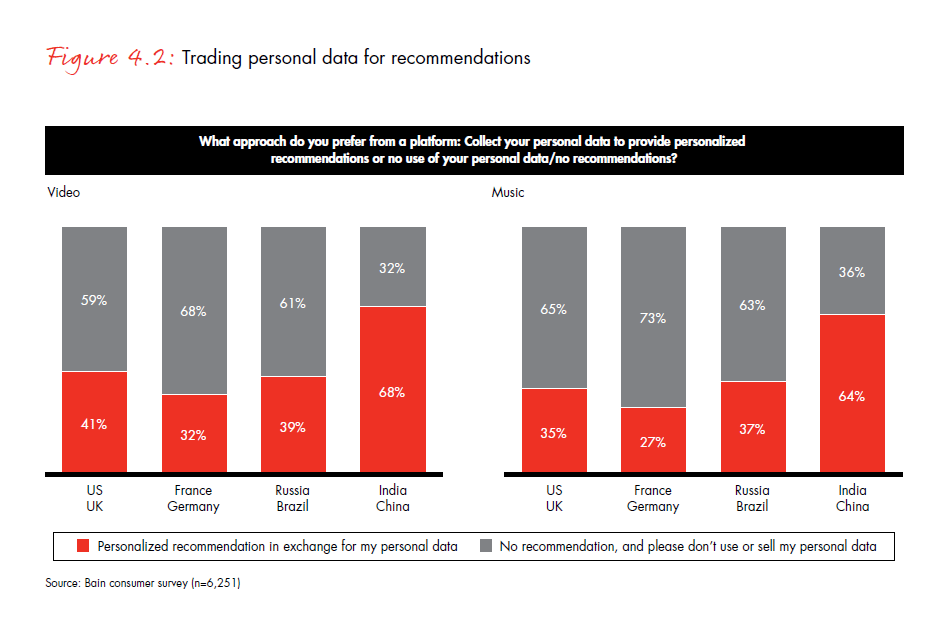
Overall, digital platforms and media companies will have to invest in noninvasive, "opt-in" viral marketing techniques to share recommendations via social networks, rather than mine the data consumers may have left inadvertently open to marketing uses. As they tread such new ground, publishers will have to manage these new sensitivities carefully, working with consumers and regulators to find the right balance between personalized services and privacy.
Re-charting funding paths for great content
As content publishers embrace new curation approaches and blend editorial flair with consumer data, one key issue remains: How will content get funded in the future?
Historically, record companies, book publishers and TV networks relied on privileged access to physically constrained space—store shelves or spectrum—to generate value. The scarcity of this distribution “real estate” guaranteed access to a critical mass of audience and revenue streams. Confident that the inherent supply constraints conferred at least a minimal value on their content, media companies could fund ambitious projects, justifying their access to mass distribution.
Will this model persist in a world where digital stores have infinite shelf space and algorithmic curation can put the smallest independent producers on an equal footing with major production studios in the eyes of the consumer?
The gradual nature of the digital transition should support the survival of existing funding models. Today, media companies can still rely on traditional audiences to monetize marquee content. As a result, they remain in a unique position to build the intellectual property and content libraries that will generate mass audiences today and tomorrow—including on digital platforms. Leveraging this starting point, they can continue to command favored relationships with distribution platforms and prime placement in digital stores, though perhaps with reverse logic: Whereas before, access to limited distribution gave them confidence to invest in quality content, their willingness now to invest in that content guarantees them access to distribution.
New monetization models also need to be accounted for. The well-charted free/paid dichotomy is increasingly challenged by freemium models, which combine a limited but functional free service with paid access to a complete offering through subscription or micro-transactions. Around 40% of surveyed gamers in Western countries report having purchased options on “free” games already. More than 15% of surveyed streaming music listeners pay for premium subscriptions that offer options like ad-free listening or using an account on multiple devices.
Such freemium models raise significant questions in terms of content funding and revenue shares. A vivid example is music, where streaming services have effectively created an intermediary space between radio (where broadcasters typically pay limited or no fees to rights holders) and downloading (where platforms pass on the majority of revenues to content owners). As neither payment model represents a relevant option for streaming services, the industry needs to define a “fair share” of revenues for each participant. This is fueling heated negotiations between platform holders, major music labels and artists. While supporting new services that can reach out to new audiences and reduce the temptation of piracy is essential to unlock additional growth— especially in emerging markets—it is also critical that artists ultimately benefit from such growth. Finding the right balance is likely to be a learning process.
In charting new territories for content generation, funding and curation, digital platforms and media companies are not the only stakeholders. Regulators will also have a critical role to play in overseeing the setting of future equilibriums. The emergence of digital curation means issues such as balanced competition between platforms, net neutrality and consumer privacy could become as essential to cultural diversity and the health of content industries as other long-standing efforts such as intellectual property protection.
The way forward
In light of ever-changing consumer dynamics and business models, content publishers can follow three critical paths:
- Invest in original content. Amid turbulence in consumer behavior and distribution models, distinct content emerges as more critical than ever. For many publishers, this will require a move upstream, from mere aggregation to increasing involvement in production itself.
- Build scale to maintain a differentiated access to talent and funding. Only those publishers who can fund a diverse portfolio of projects will be able to secure prime placement on digital platforms while absorbing the risks inherent to creative endeavors. They can achieve such scale either through vertical integration or geographic expansion.
- Embrace data analytics. Acquiring consumer data capabilities and infusing data-driven approaches into existing marketing, programming and creative processes may require a combination of talent investment, digital acquisitions and joint ventures with global and vertical platforms.
More than ever, winning strategies will be based on quality original content that stands out in an increasingly crowded marketplace. But they will also require deep, analytical insight into consumer behavior. In our view, blending these two worlds represents both the biggest challenge and the most promising opportunity media companies are facing today.
Download the full report to view the appendix
Notes on methodology
Bain & Company conducted an online survey in July 2013 with a panel of 6,251 people over the age of 15, including 1,034 in France; 1,033 in the UK; 1,056 in the US; 1,032 in Germany; 573 in Russia; and 509 in Brazil, who are representative of national populations according to gender, age, region and income, as well as 504 people in urban India and 510 people in urban China, who are representative of the urban populations according to gender, age and region.
Notes on exhibits
Penetration rate of connected devices: Percent of people owning each device. Toward an all-digital future: Percent of people having read at least one e-book over the past year; percent of people having watched at least one video online on a free website over the past year; percent of people listening to online music. Evolution of consumption times: Evolution of video consumption in the last three years for average users vs. multi-device users (people owning a smartphone, a tablet and a connected TV). The rise of the new rental services and its impact on consumption times: Percent of people paying a subscription for video streaming, music streaming or video games online—the average monthly spend is the weighted average price to the population of each country in Euro; comparison of average weekly time spent listening to music per week for subscribers to a music streaming service and for non-subscribers. Cross media consumption on digital platforms: Percent of platform users that use them to obtain video, music, books or video games; percent of people using each platform for one, two, three or four media. Competition between platforms—all platforms: Percent of people using generalist platforms (Apple, Google, Amazon, Sony) vs. specialist platforms (e.g., Netflix for video, Spotify for music, Steam for video games). Competition between platforms—generalist platforms: Percent of people using each generalist platform for video, books, video games and music. Key subscribers in media consumption—Western countries: Percent of social network members using social networks to obtain recommendations for their media consumption; percent of people using the personalized recommendations suggested by a platform in order to choose content; percentage of people using the suggestions of critics or professionals in order to choose content. Preferred curation types from platforms: Types of recommendations found most useful by platform users (platform editorial recommendations, advice from other users or automatically generated personalized recommendations). Use of personal data: Percent of people preferring personalized recommendations in exchange for their personal data vs. people preferring to keep their personal data confidential and not get personalized recommendations.
External sources
Kleiner Perkins Caufield Byers; comScore; The New York Times; paidContent; Financial Times; Sony website; Metacritic; Shortoftheweek.com; HBO; Tech Guide; AllthingsD; The Hollywood Reporter; MyMajorCompany; Digital Trends; Twitch; Netflix; SNL Kagan; Ovum
Laurent Colombani is a partner with the Paris office of Bain & Company, managing its French media activities. He has worked for more than 14 years with leading players in the media and entertainment industries. François Videlaine is a principal with the Paris office of Bain & Company. He works with major European companies in TV, book publishing, magazines and newspapers.
Bain & Company would like to thank the following people, who strongly contributed to this study: The Board and the Advisory Board of the Forum d’Avignon and the team of the Forum d’Avignon: Laure Kaltenbach, managing director; Guillaume Pfister, deputy director; and Olivier Le Guay, editorial manager.











